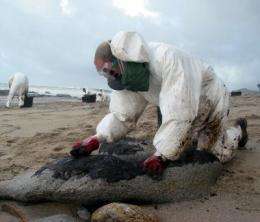It was a badly-handled course that the ship took from north to south from the moment of the accident to its sinking increased pollution. Credit: Stéphane M. Grueso
The results of a recent study by the University of Santiago de Compostela on Kentish Plover eggs has shown that there was a unexpected increase in hydrocarbon levels along the coast of Galicia five years after the Prestige oil spill. Worsened in previous years by works to remove the wreck, pollution levels began to rise again in the summer of 2006 along with numerous forest fires.
On 19th November 2002 the oil tanker Prestige sank off the coast of Galicia and spilled 63,000 tonnes of fuel oil into the sea, which reached coasts from the north of Portugal to France. The mass arrival of oil to the coast months after the accident was catastrophic.
A study by researchers at the University of Santiago de Compostela shows how progressively declining pollution levels experienced a surprising increase in 2007 due to "the wave of forest fires in Galicia in 2006," explains Jesús Domínguez, co-author of the study.
He explains that "the badly-handled course that the ship took from north to south from the moment of the accident to its sinking increased pollution between 2004 and 2006. However, the dramatic increase of 2007 can only be attributed to the forest fires."
Data were obtained through a 4 year-long observation of the levels of polycyclic aromatic hydrocarbons (50% of the fuel oil released by Prestige) in the eggs of the Kentish Plover (Charadrius alexandrinus), the only costal nesting bird on the beaches of Galicia's Atlantic Coast.
The data from before 2007 showed a progressive decline in pollution levels. Until then, figures did not exceed 120 micrograms per kilogram in any of the studied areas. Pollution levels between 2004 and 2006 are in keeping with the results obtained from the study of waters, sediment, and other marine organisms after the Prestige oil spill.
Surprisingly, an unexpected increase in pollution was recorded in 2007. According to Jesús Domínguez, researcher at the University of Santiago de Compostela, this rise could have been caused to a large extent by "the large forest fires observed during the summer of 2006 in Galicia and in other coastal areas." This suggests that oil pollution also reached the affected area by air.
According to data from the study, in 2007 pollution levels were very high. They exceeded 400 micrograms per kilogram in those areas closest to the oil spill and even exceeded 700 micrograms in those areas furthest away. In his study Domínguez concludes that this change is due to pyrogenic pollution sources, such as fires, which normally go unnoticed.
The expert recognises that "the interannual variations recorded during the study point towards a clear risk of getting close to dangerous levels" for the wildlife of the affected area. He goes on to add that the "course of the ship after the accident was so badly handled that that the fuel spread a lot more, which affected the entire Cantabrian and Atlantic coasts."
The study focused on analysing the polycyclic aromatic hydrocarbons (PAH) levels in bird eggs "given that they are easily detectable and are considered good biomonitors of pollution in this faunal group." For each egg, a study was carried out of 16 kinds of PAH classified as significant by the US Environmental Protection Agency due to their toxicity to marine organisms.
Samples were taken for four years in 10 of the species' breeding locations, nine of which are on the Galician coast beaches and one in Ría de Aveiro, Portugal. Sample areas were grouped together according to their distance from the Prestige oil spill. Three area types were established: less than 50 kilometres, between 50 and 200 kilometres, and more than 200 kilometres.
The Kentish Plover is the only wading bird that nests and breeds on Northern Spain's Atlantic Coast or, more precisely, in Galicia. This species shows signs of decline in various parts of Spain and Europe and is a priority for conservation in the European Union.
Provided by FECYT - Spanish Foundation for Science and Technology





















